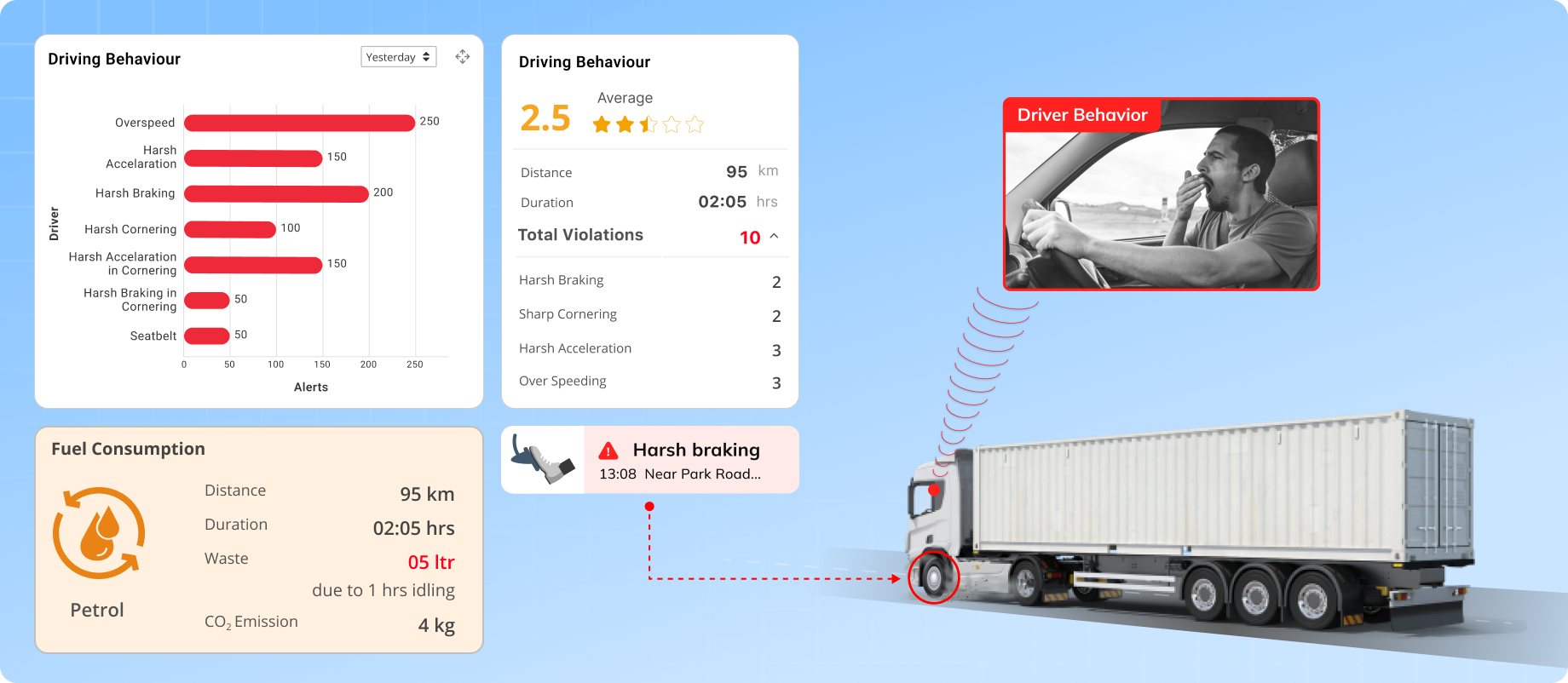In the United States, commercial fleet operators face growing pressure to improve road safety, meet FMCSA compliance, and reduce accident-related costs. Whether it’s local deliveries or cross-state trucking, unsafe driving behavior leads to insurance spikes, vehicle damage, and legal liabilities. Monitoring driver behavior in real time has become a critical need to build a safer and more efficient fleet ecosystem.
Strengthening fleet safety in the United States through driver behavior monitoring
Introduction
Challenges
- No real-time visibility into driver behavior: Unsafe actions like speeding, harsh braking, or rapid acceleration often go unnoticed until an incident occurs. Without live monitoring, fleet operators miss the opportunity to take corrective actions on time.
- Unclear patterns behind frequent violations and unsafe practices: Fleet managers lack tools to identify which behaviors are recurring or which drivers repeatedly engage in risky driving. This makes it hard to spot trends or take preventive steps.
- High fuel consumption and maintenance costs due to inefficient driving: Behaviors like excessive idling, harsh cornering, and rapid acceleration lead to increased fuel usage and wear-and-tear. Without behavior-linked data, these cost drivers remain hidden.
- No structured evaluation of driver performance across the fleet: Fleets often operate without a standardized way to rate or compare driver behavior. This limits their ability to reward top performers or identify those who need additional training.
- Inability to detect fatigue, distractions, or safety compliance violations: Drivers may drive long hours without breaks, or engage in unsafe habits like not wearing seatbelts or using mobile phones. Without intelligent alerts, these critical risks go unaddressed.
- Missing data for audits, insurance claims, or internal reviews: In the absence of detailed violation or behavior reports, fleets struggle to back safety claims, respond to audits, or build internal accountability. This weakens their compliance posture and increases liability.
Solution
- Real-time monitoring with instant behavior alerts: Unsafe actions like overspeeding, harsh braking, or rapid acceleration are detected instantly. Fleet managers receive live notifications through both web and mobile platforms. This allows immediate corrective actions and better operational control.
- Advanced driver behavior widgets for quick performance insights: Interactive widgets display driver scores, event counts, and behavior summaries within one unified dashboard. Managers can easily identify repeat violations, compare drivers, and track behavior patterns without going through lengthy reports.
- Fuel and maintenance optimization through behavior-linked analytics: The system correlates inefficient driving habits such as excessive idling or aggressive acceleration with fuel usage and vehicle condition. These insights help reduce fuel consumption and minimize maintenance costs through informed coaching.
- Driver scoring and performance evaluation system: Each driver is given a performance score based on daily and trip-wise behavior. Scorecards and trend views help managers spot top performers, recognize those who need improvement, and implement coaching or reward programs accordingly.
- Fatigue, distraction, and safety compliance detection using integrated tools: With support from Driver Monitoring Systems, the software identifies fatigue, mobile phone usage, and seatbelt non-compliance. It also detects aggressive maneuvers like harsh cornering through integrated safety systems, helping prevent accidents before they happen.
- Complete behavior reports for audits, reviews, and insurance claims: Detailed reports include driver scores, violation summaries, trip data, and activity logs. These help fleet managers comply with safety audits, support insurance documentation, and ensure transparency during internal reviews.
Results
- Improved safety and driving performance across the fleet: Real-time alerts and behavior tracking lead to a significant drop in risky driving events like overspeeding and harsh braking. Most fleets see up to a 35% reduction in major violations and a 20 to 30% boost in driver performance scores within the first two months.
- Noticeable reduction in fuel and maintenance costs: By identifying habits like idling, harsh acceleration, and sharp cornering, the system helps fleets reduce fuel expenses by up to 18%. At the same time, improved driving behavior lowers wear and tear, cutting down unscheduled maintenance by nearly 25%.
- Enhanced compliance and operational transparency: Behavior reports support FMCSA safety standards, internal audits, and insurance claims. With structured documentation in place, fleets experience faster claim processing, better insurance negotiations, and improved accountability at all levels.




